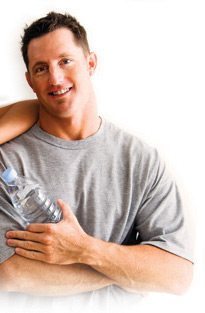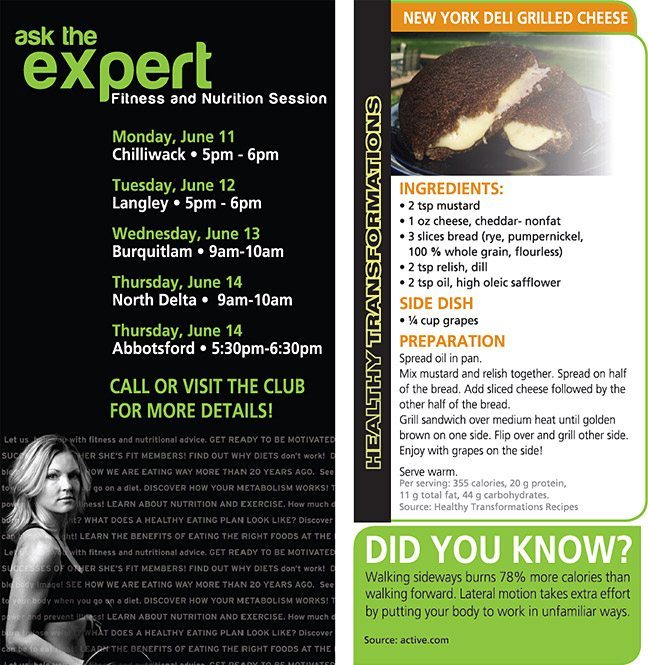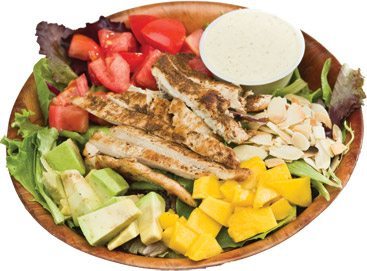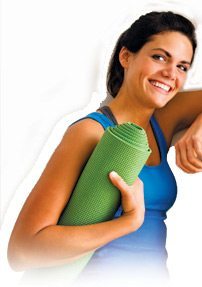

Does Exercise Make You Hungry?
Ever felt extremely hungry after a workout? A new study reveals that this isn’t necessarily the only response — in fact, the fitter you get, the less likely you are to crave food after exercise.
The study, published in the Journal of Applied Psychology, divided 30 young, fit volunteers into two groups. One group strenuously exercised on stationary bikes for an hour, the other group just sat quietly. The groups switched activities for a second session. Immediately afterward, both groups were shown pictures of different kinds of foods, from healthy salads to sugary treats, while MRIs scanned their brains for activity in the food-reward regions.
Surprisingly (at least to those of us who were extremely hungry after a workout!) it was the sitters’ brains that lit up at the sight of juicy cheeseburgers and ice-cream sundaes, while the exercisers’ did not; in fact, none of the food elicited much of a response at all for those coming off the vigorous workouts.
 Source: shine.yahoo.com
Source: shine.yahoo.com
Did You Know?
Standing up straight burns more calories than slouching – just one more reason for good posture. Stand up straight. Good posture burns more calories than slouching
Source: ezinearticles.com
Powerful Food Combinations
Looking to get the most bang out of the proverbial food buck? While a balanced diet is key to overall well-being, combining certain foods at mealtime — and avoiding some other combos — can actually increase the body’s ability to absorb key nutrients. We’ve rounded up some of the most common do’s and don’ts when it comes to food combining.
Mix and Match – Your Action Plan
DO: Pair vitamin C and iron. Some of the best sources of iron include red meat, poultry, and certain types of fish (good news for the carnivores out there). But spinach, fortified cereals, and other plant-based foods can also provide a healthy dose of the mineral (called non-heme iron). Pairing foods rich in vitamin C with non-heme iron sources helps increase the body’s ability to absorb the mineral. Iron deficiencies are especially common among vegetarians, but for all those salad aficionados, planning meals to include both vitamin C and iron can help prevent complications like anemia.
DON’T: Pair coffee, tea, and calcium with iron. While combining with vitamin C can help the body absorb more iron from foods, pairing drinks like coffee and tea and foods high in calcium with iron can have the opposite effect. Adding calcium-rich dairy to a meal (even in the form of cheese on a hamburger, for example) can reduce iron absorption by up to 60 percent! Likewise, tannins found in coffee and tea can decrease non-heme iron absorption
DO: Pair calcium with vitamin D. Calcium and vitamin D are vital to maintaining healthy bones, and matching the two can increase the effectiveness of both. Most people are actually deficient in vitamin D, though foods like egg yolks, fish, and sun-ripened mushrooms are fantastic sources that can promote calcium absorption in the body’s digestive system.
Source: livestrong.com
Ladies’ Corner
TOP 5 HYDRATING FOODS
Cucumber
The flesh of cucumbers is primarily composed of water but also contains vitamin C and caffeic acid, both of which help soothe skin irritations and reduce swelling-which is why cucumbers are often used to help swollen eyes and sunburn.
Mixed Greens Salad
Most lettuce greens contain 94 percent water, making it a low-energy density food. In other words, you’ll feel fuller on fewer calories and lose weight faster.
Tomato Sauce
It may vary depending on the brand, but most store-bought tomato sauces are about 90 percent water. Plus, one half-cup serving of tomato sauce has only 50 calories and zero grams of fat.
Zucchini
With 95 percent water by weight, Zucchini is one of the most hydrating vegetables you can eat. A healthy serving has less than 25 calories and is an excellent source of folate, potassium, and vitamins A and C.
Bell Peppers
Colourful bell peppers are 92 percent water, yet they’re still rich sources of some of the best nutrients available, including vitamin C, thiamine, vitamin B6, beta carotene, and folic acid.
Source: shape.com
 Men’s Corner
Men’s Corner
5 THINGS TO DO BEFORE YOU LIFT
Have A Drink
Muscles are around 75 per cent water, and being even slightly dehydrated can lead to a ten per cent drop in contractile strength.
Load Up The iPod
Listening to music while training makes you focus on the session so that you work out harder for less perceived effort.
Check Your Watch
Do your workouts in the afternoon. Studies have identified that body temperature naturally peaks then, meaning muscles are warmer and more flexible and strength is at its peak.
Have A Target
Numerous studies have shown that goal-setting leads to performance enhancement, so plan a training programme that allows you to increase the weight you lift over time, rather than hitting the machines haphazardly.
Brace Your Core
Your core stabilizes your body while lifting but is also involved in transferring power from your legs to your upper body when performing moves based on the chest, shoulders and back.
Source: mensfitnessmagazine.com.au


Lose weight with the right balance of carbs, fat and protein
Eat more protein to balance hormones and reduce belly fat
Protein is a necessary building block for many hormones including serotonin, melatonin, growth hormone, thyroid hormone and dopamine. If we fail to get enough in our diet, we can experience mood disorders, memory loss, increased appetite and cravings, decreased metabolism, sleep disruption, muscle loss and weight gain.
Cutting carbs can be more effective than cutting calories
Carbs trigger the release of insulin, the one and only hormone that is always telling our body to store energy as fat. As you can see then, consuming all of your calories from carbs in any given day would illict a completely different metabolic response than that caused by the consumption of fat or protein.
Remember
The primary hormone that tells your body to store energy as fat is insulin; therefore, lower insulin is always better for fat loss. Maintaining consistent blood sugar and insulin is one of the most important steps to balancing all hormones in the body and achieving lasting weight loss. Therefore, you should focus on eating foods that have the least impact on glucose levels in order to keep insulin in check. Enjoy plenty of protein, low glycemic fruit, green leafy vegetables, healthy fats and stick only to the carbs that keep your weight, mood and cravings in check.
So the next time you sit down to eat, look at your plate and ensure that you have enough protein and healthy fats to balance your hormones – because it is the source of the calories in your meal that matters most, not just the calories alone
Source: chatelaine.com
 Don’t Forget To Stretch
Don’t Forget To Stretch
Stretching is an important part of any woman’s exercise plan. Although the jury is still out as to the role of stretching in injury prevention, gentle stretching makes you feel better and many people find that stretching anytime: before, during or after a workout, or even while you’re at home watching TV, helps them feel stronger and more relaxed during workouts.
Some principles of stretching:
- Stretching is not a competitive sport. Focus on relaxing the tight muscles when you stretch. Don’t worry if you aren’t as flexible as the person next to you in a yoga class.
- Your body is different every day. Some days you are just a little stiffer; maybe you had a hard workout the day before, maybe you have been traveling and spending a lot of time sitting.
- Overall, your flexibility will improve with regular stretching, but focus on how your body feels each day, and don’t stretch to the point of pain.
- Breathe. It’s tempting to hold your breath while stretching, but you need to keep breathing to release the tension in your muscles.
- Breath smoothly and evenly while holding a stretch.
Source: womensfitness.lifetips.com
Fitness Myths
Fitness training is full of myths and misconceptions. Most of these pieces of misinformation are well-meant in that they often provide seemingly effective solutions for common fitness/fat loss problems.
Sweating off fat
Your body mass is made up from a number of components including fat, muscle, bone, internal organs and water weight. While losing water will make you weigh less, it will do nothing for fat loss. Water loss is a very temporary way to lose weight. Don’t let the scales mislead you – the only way to effectively measure fat loss is using body composition assessments such as skin fold callipers, MRI/DEXA scans and hydrostatic/underwater weighing. Scale weight doesn’t tell us what component of your body has altered.
Freeweights are dangerous
Freeweights require skill and control to use and there is often a danger associated with dropping them, freeweight exercises conform to your unique limb and joint structure. Resistance machines eliminate the risk of dropping weights on your head but they are generally built in such as way that your body must conform to the machine and not the other way round. The exception to this is exercises that use cables. In general, fixed path resistance machines are designed for “average” users and if you fall outside of the measurements used in the design of the machine, you are quite likely to be putting your body at risk far more than if you performed a freeweight exercise. If your technique is good and you have a competent spotter to hand, freeweights are probably the safest exercise option.
Healthy Living Tip!
Each month check for healthy living tips. These tips will help you with your workout, eating healthy and living well.
Deep Breathing.
When you’ve got time – at your desk, driving the car, cooking food – do some deep breathing. Inhale and count up to 5 seconds, hold it for a few seconds, and release slowly. Exchange of oxygen and carbon dioxide is one of the best things we can do for our blood and cells.










